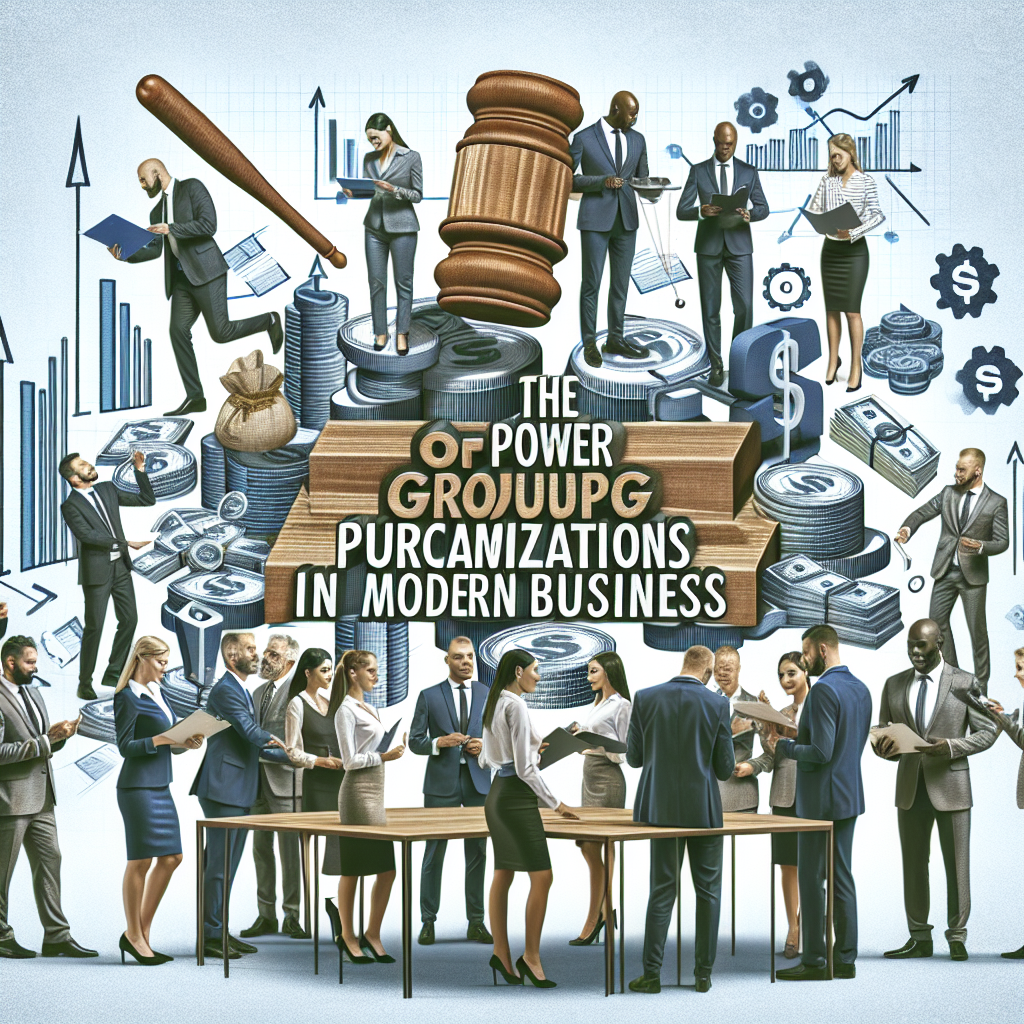Introduction
Collective buying power is a game-changer for businesses seeking to cut costs. By banding together, companies can negotiate better prices and terms from suppliers than they could on their own. This strategy not only enhances market competitiveness but also fosters significant savings.
Group Purchasing Organizations (GPOs) play a pivotal role in this process. They act as facilitators, pooling the purchasing needs of various businesses to leverage collective spend effectively. Here’s why leveraging your purchasing power through GPOs is essential:
- Access to Bulk Discounts: GPOs negotiate exclusive deals that individual businesses might struggle to secure.
- Enhanced Negotiating Power: The larger the group, the stronger the bargaining position.
- Streamlined Purchasing Process: GPOs simplify procurement, saving time and effort.
By tapping into these advantages, businesses can achieve substantial cost reductions and improve their bottom lines. However, it’s also important to understand the nuances of Purchasing Groups versus Group Purchasing Organizations, as this knowledge can further optimize procurement processes and reduce costs.
Moreover, while achieving cost reductions is crucial, it should not come at the expense of employee morale. Utilizing some of these savings on break room supplies can significantly enhance employee satisfaction and productivity in the workplace.
Additionally, employing procurement optimization strategies can streamline purchasing processes even further. It’s also beneficial to consider budget optimization tips to ensure that savings are maximized and used efficiently.
Understanding Collective Buying Power and Group Purchasing Organizations
Collective buying power is a game-changer for businesses looking to save money. At its core, it refers to the ability of multiple organizations to pool their purchasing needs to negotiate better terms with suppliers. Think of it as a group of friends going shopping together; when they buy in bulk, they often score discounts that individual shoppers can’t access.
Group Purchasing Organizations (GPOs) play a crucial role in harnessing this collective power. These entities gather member businesses—often from similar sectors or industries—to negotiate on their behalf with suppliers. By doing so, GPOs can secure more favorable pricing and contract terms due to the increased volume of purchases they represent.
Benefits for Member Businesses
Joining a GPO offers numerous advantages:
- Access to Exclusive Bulk Discounts: Member businesses gain entry to pricing that typically isn’t available to smaller buyers.
- Enhanced Market Competitiveness: By reducing costs, organizations can offer more competitive prices or improve their profit margins.
- Streamlined Procurement Process: GPOs simplify the purchasing process, saving time and reducing administrative burdens.
- Risk Mitigation: With expert negotiations and established supplier relationships, GPOs help shield businesses from market fluctuations.
Consider Hubzone Depot LLC, a certified HUBZone small business that exemplifies the benefits of leveraging GPOs. They utilize these organizations to negotiate better deals on supplies and services tailored for public sector clients, which has led them to achieve impressive savings rates while providing top-notch value and service integrity.
By embracing small business procurement strategies through GPOs, businesses can not only reduce costs but also enhance their operational effectiveness in an increasingly competitive landscape. Whether it’s securing janitorial supplies or other essential services, the power of collective buying is undeniable.
How GPOs Drive Cost Savings Through Strategic Negotiations and Strong Supplier Relationships
The purchasing process within Group Purchasing Organizations (GPOs) is designed to maximize cost savings for member businesses. Here’s a step-by-step overview of how the process unfolds:
1. Identifying Needs
GPOs start by assessing the specific needs of their members. This includes gathering data on required products or services, understanding usage patterns, and determining budget constraints.
2. Supplier Selection
After needs are identified, GPOs conduct thorough market research to identify potential suppliers that meet quality standards and pricing benchmarks. This often involves vetting multiple vendors to ensure the best fit.
3. Negotiation
The heart of cost savings lies in effective negotiation. Skilled negotiators within the GPO engage suppliers to secure favorable pricing and contract terms. These negotiations leverage the collective buying power of all member businesses, creating an environment where suppliers are more inclined to offer bulk discounts.
4. Contract Finalization
Once terms are agreed upon, contracts are finalized with clear expectations set for pricing, delivery schedules, and service levels. These contracts often include provisions for regular evaluations to ensure compliance and performance.
Building and maintaining strong relationships with suppliers is crucial for long-term success in this model. When GPOs foster collaborative partnerships with suppliers, several benefits arise:
- Trust and Reliability: Strong relationships create trust, which can lead to preferred status during negotiations and improved responsiveness from suppliers.
- Adaptability: Suppliers who feel valued are more likely to accommodate changes in order quantities or timelines, providing flexibility that can be vital for business operations.
- Continuous Improvement: Open lines of communication enable ongoing feedback regarding product quality and service delivery, allowing both parties to enhance their offerings continually.
GPOs do not merely act as intermediaries; they cultivate an ecosystem where strategic negotiations and supplier relationships flourish, resulting in substantial cost savings for all involved parties. By harnessing these elements effectively, businesses can significantly enhance their purchasing power while ensuring a steady flow of high-quality goods and services tailored to their needs.
However, it’s important to note that the successful implementation of these strategies requires a deep understanding of strategic sourcing and category management. These concepts play a pivotal role in optimizing procurement efficiency and driving value.
Moreover, myths surrounding GPOs often hinder their perceived effectiveness. Understanding the truth about GPOs can significantly boost procurement efficiency for member businesses.
Furthermore, the journey towards mastering procurement is not a straight path; it’s filled with continuous learning and adaptation. As illustrated by Frank Corris’s transformative journey in mastering procurement through learning & adaptation, strategic thinking coupled with ongoing education can drive procurement success.
Lastly, it’s worth mentioning that managing a procurement function doesn’t always require a large team. With the right strategies in place, even a one-person procurement function can be effective in driving cost savings and value creation.
Leveraging the Power of GPOs: Key Benefits and Real-World Success Stories
Utilizing Group Purchasing Organizations (GPOs) can unlock a treasure trove of benefits for businesses. Here’s a closer look at how leveraging purchasing power through GPOs leads to significant cost reductions.
Advantages of Utilizing a GPO
- Time Savings: GPOs streamline the purchasing process, enabling businesses to focus on core operations rather than getting bogged down in procurement tasks. With pre-negotiated contracts, companies can access products and services quickly without the need for extensive research or negotiation.
- Risk Mitigation: By pooling resources, GPOs help member companies minimize risks associated with supplier performance and market fluctuations. The collective power creates stability that individual businesses might struggle to find alone.
- Access to Specialized Expertise: GPOs often employ experts who understand market trends and negotiations. Members benefit from this knowledge, gaining insights that can drive better purchasing decisions.
Real-World Success Stories
To illustrate the impact of leveraging collective spend, consider these examples from various industries:
- Healthcare Sector: A regional hospital network joined a GPO and reduced its supply costs by 20% within the first year. The network accessed volume discounts on medical supplies, allowing them to allocate more funds toward patient care initiatives.
- Education Industry: A school district partnered with a GPO focused on educational materials and technology. Not only did they save 15% on textbooks, but they also secured additional training resources for teachers without increasing their budget—enhancing both educational quality and financial efficiency.
- Hospitality Sector: A chain of hotels collaborated with a GPO for bulk purchasing of linens and toiletries. This move resulted in an impressive 30% reduction in procurement costs, demonstrating how even service-oriented businesses can benefit significantly from collective buying power.
The benefits of leveraging purchasing power through GPOs are clear: time savings, risk mitigation, and access to expertise lead to drastic cost reductions for companies across diverse sectors. This approach not only enhances operational efficiency but also creates opportunities for innovation and growth.
Maximizing Collective Leverage: Strategies for Growing GPO Membership and Enhancing Negotiating Power
Growing the membership of a Group Purchasing Organization (GPO) is crucial for strengthening its collective bargaining power. The larger the member base, the more negotiating clout a GPO has with suppliers. Here are effective strategies to expand membership:
1. Networking and Outreach
Actively engage in industry events, trade shows, and conferences. Utilize these platforms to showcase the benefits of GPO membership, including cost savings and access to exclusive deals.
2. Educational Initiatives
Host webinars or workshops focused on the advantages of collective buying. Providing valuable information can attract potential members who may not be aware of how a GPO can benefit them.
3. Partnerships with Industry Associations
Collaborate with relevant associations to reach businesses that align with the GPO’s goals. These partnerships can provide access to a broader audience interested in cost reduction strategies.
4. Incentive Programs
Offer incentives for current members to recruit new businesses. This could include discounts on services or additional perks that enhance their membership experience.
Market insight plays an instrumental role in maximizing collective leverage. By leveraging data analytics, GPOs can identify emerging trends and needs within specific industries. This strategic approach enables GPOs to:
- Tailor Offerings: Understand what products or services are in demand among members and negotiate deals accordingly.
- Forecast Pricing Trends: Anticipate price fluctuations by analyzing historical data, allowing for better negotiation strategies during contract renewals.
- Enhance Supplier Relationships: Use market insights to foster stronger relationships with suppliers, which can lead to better pricing agreements and improved service levels.
However, it’s important to note that resilient procurement strategies are essential for enduring economic downturns. These strategies include sustainable practices, cost-saving tips, and effective supplier management.
Additionally, clear communication is key in procurement processes. Avoiding jargon can significantly improve stakeholder engagement and highlight the value of procurement efforts as discussed in this article about communication strategies in procurement.
Moreover, leveraging advanced procurement software solutions can optimize procurement processes by discovering key features, integration tips, and future trends for better efficiency.
Lastly, being aware of common pitfalls in procurement can help GPOs refine their strategies. Understanding these classic procurement failures and knowing how to overcome them can lead to improved efficiency and significant cost savings.
By focusing on growing membership and utilizing market insights effectively along with implementing resilient procurement strategies, enhancing communication, leveraging advanced software solutions, and avoiding common pitfalls, GPOs can significantly enhance their negotiating power leading to greater savings for all members involved.
Ensuring Sustainable Savings: Evaluating Supplier Performance and Managing Contractual Relationships Through a GPO
Maintaining sustainable savings through a Group Purchasing Organization (GPO) hinges on effective supplier performance evaluation and diligent management of contractual relationships. These practices not only ensure quality delivery but also uphold agreed-upon prices.
The Importance of Ongoing Supplier Evaluations
Regular assessments of supplier performance are crucial in a GPO framework. Consider these elements:
- Quality Assurance: Consistent evaluation helps identify any dips in product or service quality, allowing for timely interventions.
- Cost Control: Monitoring supplier pricing ensures that members receive the benefits of negotiated discounts without unexpected price hikes.
- Feedback Loops: Engaging frequently with suppliers fosters an environment where issues can be addressed promptly, enhancing overall satisfaction.
To further enhance these evaluations, businesses might consider implementing tail spend management strategies that focus on efficiently managing the less critical, yet often overlooked, portions of their spending.
Key Contractual Provisions to Monitor
When working with suppliers through a GPO, certain contractual terms deserve special attention:
- Service Level Agreements (SLAs):
- Define the expected level of service, including delivery schedules and product quality standards.
- Establish performance metrics to hold suppliers accountable.
- Dispute Resolution Mechanisms:
- Clearly outline procedures for addressing disputes, ensuring quick resolutions to minimize disruption.
- Consider including mediation or arbitration clauses to facilitate smoother conflict management.
- Renewal and Termination Clauses:
- Understand the terms under which contracts can be renewed or terminated to maintain flexibility in supplier relations.
- Assess the implications of long-term commitments on pricing and service quality.
By focusing on these areas, businesses can enhance their engagement with suppliers while safeguarding their interests within the GPO structure. Regular evaluations and attention to contractual details serve as fundamental practices that contribute significantly to achieving sustained cost savings and operational efficiency.
Moreover, leveraging advanced procurement software can streamline purchasing processes and improve overall efficiency.
In addition to this, maintaining strong supplier relationship management practices is vital for fostering positive interactions with suppliers, leading to better outcomes for both parties involved.
Lastly, ensuring contract compliance is crucial for successful procurement. Following certain best practices in procurement, such as risk mitigation and utilizing technology solutions, can greatly assist in maintaining compliance throughout the contract duration.
For further inquiries or assistance regarding procurement strategies and supplier relationship management, feel free to contact us.
Exploring Industry-Specific Applications of Collective Spend Strategies Beyond Healthcare
While healthcare organizations are often the poster children for Group Purchasing Organizations (GPOs), they aren’t the only players in the game of collective spend. Industries like hospitality, retail, and education can harness bulk buying power just as effectively.
Key Considerations for Non-Healthcare Sectors
1. Understanding Unique Needs
Each industry has its specific procurement requirements. For instance, a restaurant may prioritize food quality and freshness, while a school might focus on educational materials and technology. Identifying these needs is crucial.
2. Supplier Selection
Look for suppliers experienced in your industry. A GPO that specializes in hospitality will have different connections than one focused on healthcare, ensuring you get the best possible deals tailored to your sector.
3. Leveraging Expertise
Many GPOs offer valuable insights into market trends and pricing strategies. By tapping into this knowledge, businesses can make informed decisions that benefit their long-term financial health.
4. Networking Opportunities
Joining a GPO opens doors to collaborate with other businesses facing similar challenges. Sharing experiences can lead to innovative solutions and cost savings.
5. Adapting Best Practices
While healthcare has paved the way for collective purchasing strategies, other sectors should adapt these methods to fit their unique circumstances, ensuring effective implementation of cost-saving measures.
By recognizing the potential of collective spend beyond healthcare, businesses can unlock significant savings and enhance their competitive edge through strategic partnerships with GPOs.
Expanding the Scope of Collective Spend Management
Collective spend strategies can also be applied to manage indirect spend effectively. This type of spending often includes items that are not directly tied to the production of goods or services but still play a vital role in business operations. Understanding how to optimize these expenses is crucial for overall cost savings and efficiency.
Moreover, it’s essential to consider tail spend management as part of your procurement strategy. Tail spend refers to the small percentage of purchases that fall outside the regular buying patterns, often leading to inefficiencies and increased costs if not managed properly. By treating tail spend as a distinct category and implementing effective category management strategies, businesses can unlock hidden savings and enhance efficiency.
Communication plays a vital role in successfully implementing these strategies. It’s important to be able to communicate procurement’s strategic value to the C-Suite effectively. This involves aligning procurement goals with overall business objectives and showcasing success stories that highlight the value brought by strategic procurement initiatives.
The principles of collective spending extend far beyond healthcare, offering valuable insights and strategies that can be leveraged across various industries for improved efficiency, cost savings, and enhanced competitive advantage.
Navigating Challenges and Making Informed Decisions When Engaging with Group Purchasing Organizations
Engaging with Group Purchasing Organizations (GPOs) can yield significant benefits, but it’s essential to navigate potential challenges in collective buying. Here are some common obstacles businesses might face:
1. Resistance from Internal Stakeholders
Employees or management may be hesitant to adopt GPO strategies. This reluctance often stems from a lack of understanding about the benefits or fear of change.
2. Contractual Limitations
Existing agreements with suppliers could restrict a company’s ability to leverage GPO opportunities. These contracts may include exclusivity clauses or minimum purchase requirements that hinder flexibility.
3. Misalignment of Goals
Not every GPO aligns perfectly with the specific needs of a business. If the GPO’s focus doesn’t match your operational goals, it can lead to wasted resources and missed savings.
4. Communication Gaps
Effective communication is vital for success. Misunderstandings about pricing structures, service expectations, or terms can create friction between members and suppliers.
Addressing these challenges involves proactive engagement and open discussions within your organization. By fostering a culture that embraces collective purchasing, you can unlock the full potential of GPO partnerships.
Taking Action: Joining Forces for Greater Financial Resilience Through Collective Spend Initiatives Like Group Purchasing Organizations (GPOs)
The long-term financial benefits of joining a GPO can be remarkable. Here’s what you stand to gain:
- Sustained Savings: Regular participation in a well-managed GPO leads to consistent cost reductions over time. You’ll enjoy exclusive bulk discounts and favorable pricing that simply aren’t available to businesses acting alone.
- Enhanced Resource Allocation: With less money spent on procurement, your organization can invest more in growth initiatives. Imagine redirecting those savings into innovation or employee development.
- Community Support: Joining forces with other organizations not only strengthens your purchasing power but also builds a network of support. Collaborating with like-minded businesses creates opportunities for shared insights and best practices.
If you’re intrigued by the idea of leveraging collective spend for drastic cost reduction, don’t wait!
Explore this avenue today! By joining a GPO, you position your business to take advantage of potential savings that could significantly impact your bottom line. The sooner you act, the more benefits you’ll unlock.
Don’t miss out on the chance to enhance your financial resilience through collective purchasing initiatives. This is an opportunity waiting at your doorstep—take that step towards greater savings and efficiency now!





